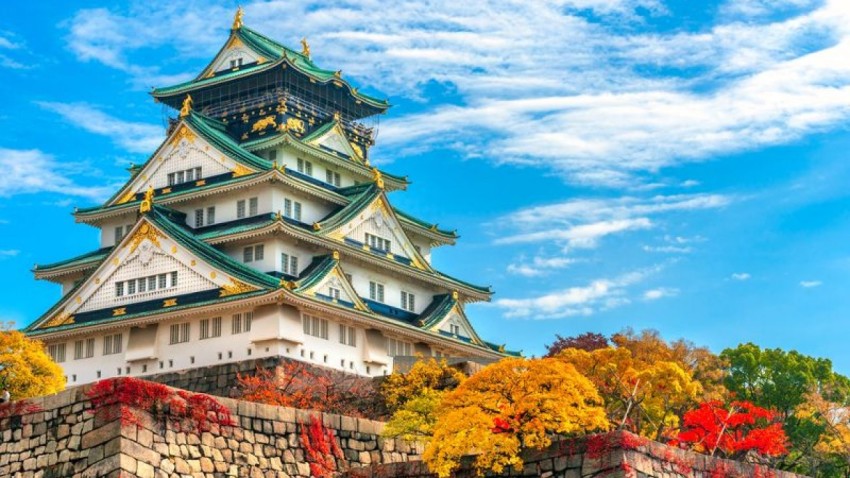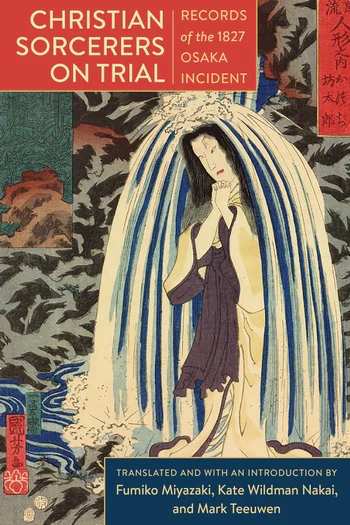Books: Christian Sorcerers on Trial
August 23, 2020 · 0 comments
By Jonathan Clements.
 It didn’t matter that some of the accused had already died in prison. When they were sentenced in 1829, the survivors were marched through the streets of Osaka, along with the salt-preserved corpses of their fellow believers. Then all, dead or alive, were crucified as devotees of the “pernicious creed” that worshipped Jesus Christ. As discussed in the new book Christian Sorcerers on Trial, the “Osaka Incident” scandalised samurai-era Japan. A forbidden foreign cult, long thought to have been wiped out, had popped up again in the middle of Japan’s mercantile metropolis, in the shadow of Osaka Castle itself.
It didn’t matter that some of the accused had already died in prison. When they were sentenced in 1829, the survivors were marched through the streets of Osaka, along with the salt-preserved corpses of their fellow believers. Then all, dead or alive, were crucified as devotees of the “pernicious creed” that worshipped Jesus Christ. As discussed in the new book Christian Sorcerers on Trial, the “Osaka Incident” scandalised samurai-era Japan. A forbidden foreign cult, long thought to have been wiped out, had popped up again in the middle of Japan’s mercantile metropolis, in the shadow of Osaka Castle itself.
 Author-translators Fumiko Miyazaki, Kate Wildman Nakai and Mark Teeuwen observe that the Osaka Incident has been little discussed because it “tended to get caught in the cracks between academic specialisations.” Just as the Shimabara Rebellion of 1637 was too secular to appeal to Christian historians, and too much of a massacre to appeal to military buffs, the Osaka trials dealt with a sect whose idea of Christianity was somewhat self-styled, possibly unrelated to the nests of Hidden Christians that, we now know, still persisted in the countryside and on remote islands.
Author-translators Fumiko Miyazaki, Kate Wildman Nakai and Mark Teeuwen observe that the Osaka Incident has been little discussed because it “tended to get caught in the cracks between academic specialisations.” Just as the Shimabara Rebellion of 1637 was too secular to appeal to Christian historians, and too much of a massacre to appeal to military buffs, the Osaka trials dealt with a sect whose idea of Christianity was somewhat self-styled, possibly unrelated to the nests of Hidden Christians that, we now know, still persisted in the countryside and on remote islands.
The founder of the sect, Mizuno Gunki, was already dead by the time it was rooted out, and is one of those fascinatingly slippery historical characters. Like many a charismatic cultist, he had an early career as a conman and ne’er-do-well, before suddenly finding God. Initially, it seems, his knowledge of Christianity was derived not from any direct contact with Christians, but from reading the persecution manuals of their samurai enemies. Some of his followers may have been legitimate Hidden Christians, creating a miasma of confused practices, half-understood rituals, and occult behaviours.
Even the inquisitors of these “Keihan Kirishitan” treated many of them as quasi-Christian – a bunch of deluded commoners who thought they had joined an underground religious sect, but had actually signed up for a series of parlour tricks, fortune-telling sessions with a local medium, and blood-letting rituals centred around a magic painting called The Lord of Heaven. This is what the authors mean when they say it has been “caught in the cracks.” They might have been Christians, but they might have been nutters, or they might have been Buddhists, or some sort of hybrid like the Taiping rebels who would rise up a generation later in China.
Miyazaki et al’s book may be edited and curated, but like their previous Lust, Commerce and Corruption: An Account of What I Have Seen and Heard, by an Edo Samurai, they largely leave the subjects to speak for themselves in long, annotated transcripts of their interrogation. So it is, that on the very first page of the “witch” Sano’s testimony, I see her admitting that her ancestors might have been members of the Ikko Ikki – the “leagues of one mind” that briefly formed separatist, anti-samurai Buddhist enclaves until they were wiped out in the 16th century. In her accounts of “performing austerities” and casting spells, there may even be still further cracks to fall through. In describing them as quasi-Christians, or almost-Buddhists, we may be committing the same error as their persecutors, demanding that they fit into proscriptive boxes that we have defined for them, rather than recognising an inherent, numinous yearning for belief and transcendence.
It’s become something of a running gag in NEO magazine’s Manga Snapshot column that so many contemporary Japanese women’s magazines come with adverts and advertorial for astrologers and witchy assistance, sometimes backed by manga retellings of their greatest achievements and predictions. But these tall tales resonate, sometimes word for word, with the boasts and claims of the Keihan Kirishitan, offering solace, support and meaning to the lives of down-trodden and depressed people… often for just a few pieces of silver. Christian Sorcerers on Trial offers a deep insight into the lives of Osaka’s 19th century underclass, as the cultists recount their hard-luck stories, bankruptcies and misfortunes, but that only takes us to the book’s halfway point.
It is equally exciting to read the judges’ deliberations, as a bunch of samurai lawyers debate the nature of precisely which crimes, if any, have been committed. They discuss Christianity as if it were an ancient pandemic – a religious virus that has been carefully stamped out nearly 200 years earlier, with periodic outbreaks that have to be strictly monitored. We get a sense, in at least some of the comments, that some are gently questioning the statutes, wondering if it is really fair to impose regulations drawn up two centuries earlier upon contemporary people.
 There are, they observe, some districts where people with Christian ancestors are still annually vetted to make sure their infection has not manifested itself once more. This was achieved by making them step on a Christian icon, the fumi-e or Trampling Image, proving that it meant nothing to them. But Sano herself, the leading survivor, had herself supposedly walked across a fumi-e, so was she Christian or not? And if she wasn’t, should she be punished for a lesser crime of charlatanry? There is also a ghoulish set of pages as the judges check the regulations for disposing of Christian corpses, which apparently include a directive to check for “unusual circumstances” before releasing it. What on Earth were they!?
There are, they observe, some districts where people with Christian ancestors are still annually vetted to make sure their infection has not manifested itself once more. This was achieved by making them step on a Christian icon, the fumi-e or Trampling Image, proving that it meant nothing to them. But Sano herself, the leading survivor, had herself supposedly walked across a fumi-e, so was she Christian or not? And if she wasn’t, should she be punished for a lesser crime of charlatanry? There is also a ghoulish set of pages as the judges check the regulations for disposing of Christian corpses, which apparently include a directive to check for “unusual circumstances” before releasing it. What on Earth were they!?
The book’s final third recounts the later fallout from the incident, including accounts overheard from sumo wrestlers, who as itinerant wanderers, saw more of the country than most, and were often sources of gossip. The stories include an uprising ten years later in Osaka, where rumour-mongers reported a rebel leader eluding the authorities through the use of “Christian sorcery.” Except the leader in question was Oshio Heihachiro, the supposedly incorruptible inquisitor who had interrogated the Keihan Kirishitan – so had he been one of them all along… or had they converted him from beyond the grave, either through their books or through hauntings…? Or was it all just a silly urban myth, designed to push the blame for samurai grievances onto foreign trouble-makers?
These later myths present compelling new twists on the drama. Years after Mizuno Gunki’s death, he is described as a man “from Shimabara” who carried the poisonous local occult beliefs to Osaka. But Christian sorcerers are pointedly described as members of an underclass that had survived the “fall of Osaka Castle” – in other words, that ever since the brutal end of the samurai wars in 1615, there had been a group hidden among the common Japanese people, a secret society defined in part by Christian leanings, but also by their connection to the clans that had been on the losing side, biding their time for more than 200 years until the chance came to strike back at the Shogun’s family. Such speculations, of course, have proved to be a rich vein of inspiration for many a pulp novelist and manga creator.
Jonathan Clements is the author of Christ’s Samurai: The True Story of the Shimabara Rebellion. Christian Sorcerers on Trial: Records of the 1827 Osaka Incident is published by Columbia University Press.
Leave a Reply